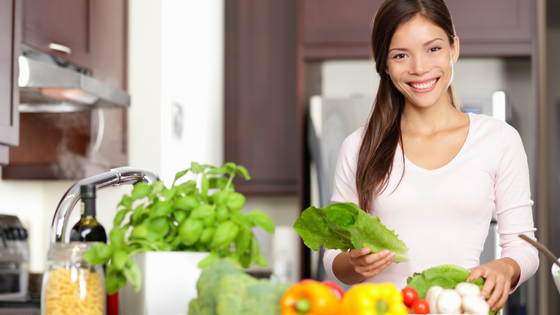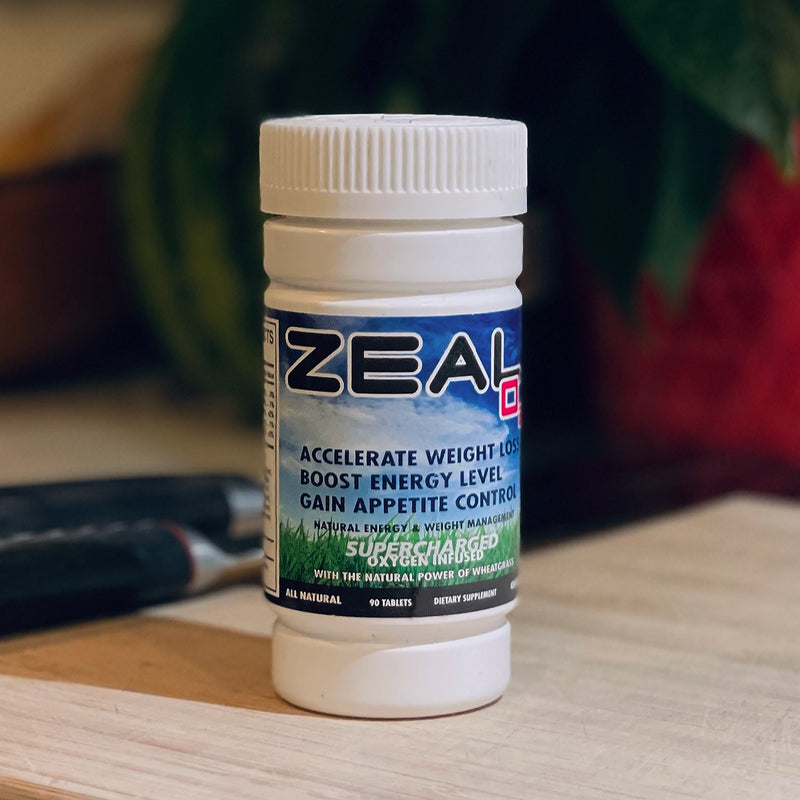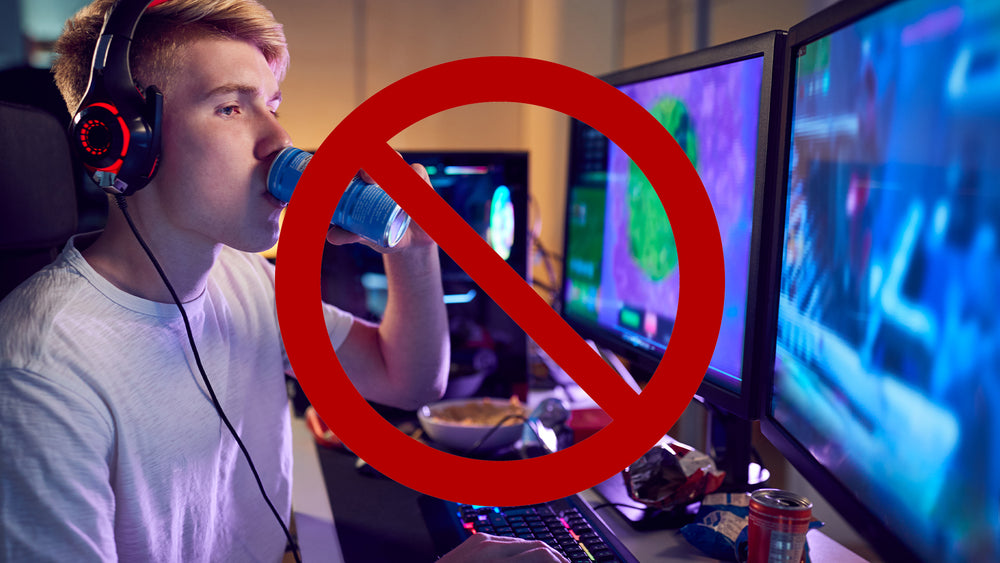The benefits of cooking at home outweigh the supposed convenience of eating out in restaurants. With all the interest in healthy eating, many restaurants offer gluten-free, salt-free and sugar-free options, but unless you're visiting a vegan restaurant, most menus offer only a handful of healthy choices.
Findings from a 2014 Johns Hopkins Bloomberg School of Public Health study showed people who cooked at home consumed fewer calories, less fat, less sugar and fewer carbohydrates than those who ate out regularly. Study subjects who prepared meals at home six or seven days a week also ate less when they did eat in restaurants. Research also showed that people who worked 35 or more hours a week cooked less, and people who cooked at home were less likely to eat fast-food when they did eat in restaurants.
The Benefits of Cooking at Home vs. Eating Out
When you cook at home, you control the amount of salt, sugar, and starch going into a recipe, determine the portions, the size of the plates used, and control the cleanliness of your kitchen. You don't need to worry about parking, wait around to be seated or served, or leave a tip. However, you will need to prepare the food (including shopping), store it properly, cook the food, set the table, clean up after the meal and do dishes.
Eating in restaurants is relaxing. You don't have to shop, cook or clean up, and you can socialize with friends or family between bites. Restaurant meals, even fast food burgers, are more expensive than home-cooked meals and are unhealthier, since most professionally-prepared meals have more fat, sodium, sugar and/or calories than homemade dishes. And you'll need to set aside time for traveling to and from the restaurant, waiting for the food and waiting to pay.
If you are already cook at home on a regular basis, you're reaping many of the physical, mental and social advantages of eating whole, healthy meals made from scratch. If you eat out all the time, you may want to look at some of the health benefits of cooking at home.
1. Saving Money is One of the Benefits of Cooking at Home
Spending your lunch hour at work in fast food joint or diner drains your paycheck. A simple restaurant lunch can set you back 10 dollars or more. If you multiply that by 5 days a week, 20 days a month, a sizable chunk of your income disappears on food that may be ruining your health. While an occasional dinner out (or pizza delivery once a week) isn't much of a monetary drain for most people, eating out once or twice a day is a strain on your finances. Cooking at home provides you with plenty of tasty leftovers for tomorrow's lunch- or the know-how to whip up something fresh for a brown bag lunch. Brown-bagging your lunch can save you $2,500 a year, according to this Time magazine article
2. Saving Time is One of the Unexpected Benefits of Cooking at Home
The eating out ritual goes something like this – drive to a restaurant, wait to order, wait to be served, eat, wait for the check, wait to pay and drive home. This can take up to two hours, the same amount of time it takes to prepare, serve and eat a home-cooked meal.
3. Family Togetherness
In today's fast-paced, digital age, families either eat on the go or in front of the TV or computer. Not exactly the best approach for family bonding. Preparing and eating meals together- even cleaning up when dinner's over - invokes a sense of camaraderie.
Teach your children to cook. It's a skill sorely lacking in many younger people today, and your kids will be able to use it all their lives. Cooking with kids helps them learn how their diet affects health and energy. It gives them more self-confidence, and encourages them to conquer other tasks outside the kitchen. It teaches them to be self-sufficient. They won't be dependent on adults to prepare scrambled eggs or other simple meals.
{WGL_PRODUCTS title="Healthy supplements to make you feel better."}
4. Home Cooking Helps You Live Longer
People who cook at home up to five times a week are 47% more likely to live another 10 years, according to research conducted on a group of elderly Taiwanese citizens. Frequent cooking benefited women more than men, and other factors, including eating less meat and walking at least twice a week, contributed to longevity. The benefits of cooking at home can keep you healthy and energetic way into your golden years.
5. Nutritionally Balanced Meals
The benefits of cooking at home include eating more nutritionally balanced meals. Using fresh fish, poultry and butcher-cut meat from a supermarket, and fruits and vegetables from a farmer's market, you'll boost the vitamin and mineral content of meals. Home cooking increases the amount of fiber, iron, calcium, Vitamin B6, Vitamin C, Vitamin A, Vitamin B12 and Vitamin E you consume, and also lowers the saturated fat content of food.
When you prepare your own meals, you can season them to taste. You won't consume innocuous-looking food with hidden amounts of salt, sugar and artificial flavors. Plan meals and shop at the supermarket with a grocery list ; don't wing it. Look up recipes or create a master list of healthy foods to choose from at the market.
6. Cooking at Home Lowers Calorie, Fat and Sodium Intake than a Restaurant Meal
If you want to maintain your current weight or even lose weight, home cooking helps you subtract at least 140 calories a day over eating in restaurants. Even if you cook the same meal you normally order at a restaurant in your own kitchen, you'll use less sugar, salt, butter and oil than a professional chef.
Many fast food and sit-down restaurant chains offer entrees that supply the daily recommended amount of calories, sodium or cholesterol in one meal.
Eating in a restaurant increases calories by 50% and can also increase sodium and fat, according to this USA Today article. Ordering food in a restaurant is based more on eye appeal (what looks good on the menu), what your friends/family are eating, how fast the service is, and other variables that have nothing to do with health or nutrition. Eating in restaurants is a social activity for most people. While relaxing with friends, you're less apt to worry about what you're eating or how much (and you're more likely to order drinks and dessert). When you eat alone, a fast-food lunch on a busy day, for example, you may eat too fast, which causes overeating and may cause digestion problems.
- Make Better Choices When You Eat in Restaurants
If you've given up fast-food, but still eat out at diners and full-service restaurants, you may be trading down. A typical restaurant meal increases daily fat intake by 10 grams and adds 187 calories to your daily total, according to a study published in the European Journal of Clinical Nutrition. Restaurants are notorious for serving large portions, and most people tend to eat everything that's on their plate, racking up the day's calorie count.
When you do eat out, choose healthier foods. Order a baked potatoes (sans sour cream) or vegetables as a side dish instead of French fries. Share your meal with your dining companion, or order an appetizer and salad instead of an entrée. Avoid fried foods; order roasted, broiled or baked main dishes instead. End your meal with fruit or sherbet for dessert instead of a high-calorie slice of cake. If you want to lose weight, drink a glass of water or a cup of tea before eating. It'll fill you up, making you eat less.
7. Food Appreciation- You'll Enjoy Meals More When You Cook at Home
Preparing your own meals helps you to be more aware of what you eat and its nutritional value. When you grab food on the go, you aren't really paying attention to how much you eat or even how it tastes. Buying groceries, planning meals and cooking (with or without help from your family or Significant Other) reinforces the value of certain foods and encourages you to think more about portion size and calories. As a result, you'll eat less and learn to select foods based on taste and economy instead of ordering something quick from a limited menu.
8. Better Food Safety
Food poisoning affects millions of Americans each year, with increased instances of E.coli, listeria, salmonella and other foodborne pathogens found in restaurant food and prepackaged meals. When you eat in a restaurant or get takeout food, you won't know how ingredients have been stored, cooked and handled. Even if you eat at a restaurant has an A rating from the Board of Health, you won't know if they keep up cleanliness standards between each inspection. You have control over storage, cooking times and temperatures at home, which gives you peace of mind and ensures a properly prepared meal.
Foods most commonly associated with food poisoning include:
- Raw fruits and vegetables that have been processed in unsanitary conditions or not washed properly
- Animal-based foods containing product from many different animals, such as ground beef, which may contain meat culled from hundreds of different cows, and chicken, which may be exposed to drippings from other birds in the same processing unit.
- Raw milk, unpasteurized milk and fruit juice, raw shellfish, raw meat and poultry and raw eggs
How to Make Home Cooking Healthier
Add more veggies to your meals.
Add fresh or pre-cut, frozen vegetables to stews, soups, homemade pizza, omelets and
sandwiches. This adds nutrition without adding many calories. Veggies are an excellent source of Vitamin A, B complex vitamins, Vitamin C, iron, Vitamin K and calcium. If you're short on time and can't cook from scratch, add microwaved vegetables to frozen or prepared foods.
Make fruit smoothies.
Buy fresh or frozen berries or other fruits to make Vitamin C rich smoothies. Add plain yogurt, honey, flax seeds and ice cubes for a cold treat that's healthy and tasty.
Use a slow cooker.
If you want to cook at home, but feel you don't have the time, invest in a slow cooker, aka a crockpot. Clear some counter space and position the cooker about six inches from the wall and other appliances. Check out some slow cooker recipes online or from friends. Chop vegetables and trim meat, add spices (or whatever the recipe calls for) and put the ingredients in the slow cooker. Fit the lid over the cooker tightly so steam doesn't escape, and set the temperature. Higher temperatures heat the food in 4 to 6 hours; lower temperatures in 8 to 10 hours. When you get home from work or a day out, turn the cooker off, serve and enjoy.
Wheatgrass Love Supplements Increase the Nutritional Benefits of Cooking at Home
A wheatgrass supplement offers hundreds of nutrients to improve your health. All the vitamins you need for optimal health, including Vitamins A,E,C, K and B-complex vitamins, are found in chlorophyll, the main building block of wheatgrass. Chlorophyll promotes healthy hair, skin, eyes and liver; increases your energy; detoxifies and flushes out toxins in your body and increases blood flow and oxygen. The chlorophyll in wheatgrass also contains hundreds of enzymes to enhance digestion, metabolism and chemical reactions in the body. Zinc, magnesium, calcium, potassium, phosphorus, iodine and iron are some of the minerals in chlorophyll. And chlorophyll also provides 20 amino acids to produce proteins and maintain muscle and bone health.
Wheatgrass Love offers three wheatgrass supplements to increase the nutrient benefits of cooking at home.
Zeal O2 Weight Loss Supplement and Energy Booster suppresses your appetite naturally with a proprietary blend of Citrus Aurantium (bitter orange), cayenne pepper, green tea extract, gotu kola and over a dozen other herbs. Along with the vitamins and minerals in high-grade wheatgrass, Zeal O2 supplies all the nutrients you need to stay healthy, energetic and thin. Control your weight with Zeal O2 and the benefits of cooking at home. Read more about Zeal O2.
REVV Natural Energy Supplement increases your vitality and endurance with a blend of wheatgrass, caffeine, cocoa, B-complex vitamins and periwinkle herb, (which has been found to reduce Alzheimer's and dementia). These chocolate mint wafers taste a lot better than most energy drinks, and you can take them as needed. Read more about REVV.
HappyGirl Natural Mood Enhancing Supplement reduces mood swings and non-clinical depression in men and women. It offers the same B-complex vitamin-enhanced wheatgrass as REVV and Zeal O2, along with an herbal blend of green tea extract, cayenne pepper, ginger, ginseng, damiana and may more mood-boosting herbs. Read more about HappyGirl.
Call us at 877-303-1717 if you have any questions about wheatgrass, or to order REVV, Zeal O2 or HappyGirl. Wheatgrass Love products offer additional nutrition to supplement the benefits of cooking at home.
















